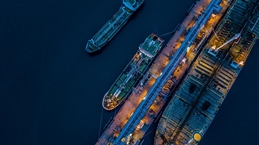
Shipping lines are still very much in flux when it comes to meeting upcoming requirements for burning low sulphur fuel.
The International Maritime Organization will, on January 1, 2020, begin enforcing a rule which limits the amount of sulphur in marine fuel to just 0.5%, down from a cap of 3.5%. Options for shipping lines to achieve the mandate include burning fuel with lower sulphur content, installing scrubbers to reduce gas emissions or using liquefied natural gas as their fuel source. The IMO says the new limit on sulphur will result in a 68% overall reduction in shipping’s negative effect on human health through air pollution. Shipping lines presently run on a heavy fuel oil, the byproduct of crude oil distillation.
While COSCO is reported to have inked a deal for low sulphur fuel in 2020, there is scant news of other lines having the same luck. And that has some worried about blank sailings caused by the lack of appropriate fuel.
Lines are in broad agreement that the low sulphur fuel requirement will almost certainly add to a price increase that will be passed on to shippers.
“Very few of us have a clear idea of what that will actually mean of added costs come 2020,” said Uffe Ostergaard, president of Hapag Lloyd America, speaking at the Georgia Foreign Trade Conference in February. “There are a number of measures we’re taking. We have tested scrubbers, we have a fleet of LNG-ready ships we’re testing now, but the realization, at least from our point of view, is that over the past couple of years, we’ve been turning a profit of a hundred million dollars out of a turnover of 12 billion, so certainly nothing that gets shareholders excited, right?”
And if, on top of that, you have to take on an extra fuel bill of a billion dollars, that cost has to go somewhere, Ostergaard said. “That discussion is being taken very constructively by most of our partners. We’ve tried to make it as transparent as possible.”
Ostergaard said that the most likely outcome of increased fuel costs is that shippers will see those increased costs passed on to them. “What the additional cost is going to look like, it’s too early to tell, but it will create a lot of disruption,” he said.
George Goldman, president of ZIM American Integrated Shipping Services, noted that shippers and shipping lines are going to face a difficult discussion.
“One of the questions is, how do you see this dialog going when you sit down with shippers to negotiate contracts? It’s a difficult dialog,” he said. “The forefront of it is that we all understand that it’s there.”
Goldman said that the need for each side to state its requirements clearly will enter many a contract discussion. “We all use the fact that there’s a bunker price, but our ability to articulate is a challenge,” he said. “When you look at our bunker formulas, and then shippers have their own bunker formulas, and when are they all in effect, and when do the contracts expire. And all of us will start burning this in the third or fourth quarter of this year, so when do we apply it to contracts we’re signing right now?”
“It’s a contentious dialog, but it is one that needs to be happening,” he said. “When you sit down with a shipper, you have to really prioritize what it is you want to hit in the contract, and bunker is, for all of us, probably number one. When you get down to it, there are a lot of other elements that are going be involved, and you can’t lose sight of them.”
Fabio Santucci, president of Mediterranean Shipping Company (USA) says it is “unthinkable” that shipping lines won’t pass the additional costs on to shippers.
“The estimated increase for the whole industry is roughly US$15 billion a year. MSC’s share is roughly US$2 billion. Given the financial performance and everything else we’ve seen in the past few years, it’s unthinkable that the carriers would be left alone with this burden,” he said. “But at the same time, this is an opportunity for the industry, because while we can design bunker formulas that are more comprehensive than ever before, I think there is one goal that everyone is trying to achieve, and that’s more transparency and, given the fluctuations of the market, to make this more predictable. There are going to be monthly variations, quarterly variations in spot quotes and in contracts, and it’s too early to tell which formula will be the best.”
Santucci said that the industry is having “very open conversations” and that shipping lines “showing customers our real cost.” He also believes that the mandate for low sulphur fuel – and the additional costs that it will entail – could spell the end of the all-in rate.
“That mechanism has to be better than what we had in the past. When you had the fuel embedded in the all-in rate in the older pricing, I don’t think that’s really the best way, but as long as we’re doing this together and are transparent in the formula, it is an opportunity to add more clarity.”
Goldman said much the same thing. “Our objective is to delink the bunker freight discussion from the freight discussion. The worst thing we see is all-in rates. We’re not here to make money on the bunker rate going up and down, but we do want to pass it on.”
By Gregory Glass
Asia Cargo News | Saint Simons Island, Georgia



